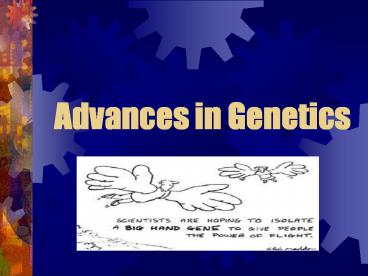Advances in Genetics - PowerPoint PPT Presentation
1 / 16
Title:
Advances in Genetics
Description:
Title: Advances in Genetics Author: Hannah Kelderman Last modified by: Madison County Schools Created Date: 5/3/2005 4:10:54 PM Document presentation format – PowerPoint PPT presentation
Number of Views:290
Avg rating:3.0/5.0
Title: Advances in Genetics
1
Advances in Genetics
2
Methods of Developing Organisms With Desirable
Traits
- Selective Breeding
- Cloning
- Genetic Engineering
3
Selective Breeding
- The process of selecting a few organisms with
desirable traits to serve as parents of the next
generation. - Used for thousands of years with various plants
and animals. - Types
- Inbreeding
- Hybridization
4
Inbreeding
- Two individuals that have identical or similar
sets of alleles are crossed. - Resulting organisms are very similar to their
parents. - Used to produce breeds of animals with specific
traits - Ex. Purebred Lab retrievers, German shepherds
- Increases probability that organisms may inherit
alleles that lead to genetic disorders. - Ex. Hip problems in many breeds of dogs
5
Hybridization
- Two genetically different individuals are crossed
- Organism is bred to have the best traits from
both parents - Ex. Corn with many kernels crossed with
disease-resistant corn - Most crops grown on farms and in gardens are
hybrids.
6
Cloning
- Although selective breeding does not allow the
breeder to control whether the desired allele
will be passed or not, cloning does. - Clone
- Organism that is genetically identical to the
organism from which it was produced. - Cloning Plants
- Small part is cut from plant and regrows into a
genetically identical plant.
7
Cloning in Plants
8
Cloning Animals
- Dolly the Sheep
- Removed egg cell from one sheep
- Nucleus in egg cell replaced with nucleus from a
six-year old sheep - Egg implanted into uterus of 3rd sheep
- Dolly born 5 months later, genetically identical
to the six-year old sheep
9
Genetic Engineering
- Genes from one organism are transferred into the
DNA of another organism. - Called Gene Splicing
- DNA molecule cut open
- Gene from another organism is spliced into it
- Used to
- Produce medicine
- Improve food crops
- Try to cure human genetic disorders
10
Genetic Engineering in Bacteria
- Bacteria used because they reproduce rapidly.
- Insulin gene spliced into bacteria- (into the
plasmid)- so that the bacteria will produce
insulin.
11
Genetic Engineering in Bacteria
12
Genetic Engineering in Other Organisms
- Used in plants and other animals.
- Ex. Human clotting gene inserted into cows.
Cows then produce clotting protein in milk, which
can then be extracted for humans. - Gene Therapy
- Working copies of a gene inserted directly into
cells of a person with a genetic disorder - Used to correct some genetic disorders
13
Genetic Engineering
14
DNA Fingerprinting
- DNA pattern is unique for each individual
- Used often in crime investigations
15
Human Genome Project
- Identified the DNA sequence of every gene in the
human genome. - Involves nearly 25,000 genes
- May lead to new treatments and prevention
strategies for many genetic disorders and for
diseases such as cancer.
16
Summary Questions
- Name three techniques that people have used to
produce organisms with desired traits. - Why do scientists want to identify the DNA
sequence of every human gene? - What is genetic engineering? Describe three
possible benefits of this technique. - Explain how a DNA fingerprint is produced. What
information can a DNA fingerprint reveal?































